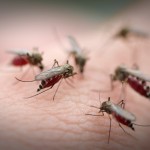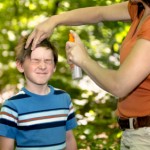Given that mosquitoes can carry a variety of diseases, West Nile among them, I wondered how best to deter them from biting us and transmitting viruses and other pathogens?
Let's start with a brief overview of their life cycle. Most adult female mosquitoes must have a blood meal in order to lay eggs. Thus they are the only ones who bite us and other animals (Males feed on plant juices and unlike humans, apparently don't extend their life span by doing so.) They live about a week, whereas their other-gender "mates" may live a month. They mate rapidly, finding each other by sound (males and females will match wing-beat sounds) and inseminated females will not mate again. That doesn't hold true for the males, but some may lose their sexual apparatus in mating.
The females show a distinct preference as to where they lay their eggs; this varies by species, but must be on water. Of the 2,500 plus species worldwide and the 150 species of mosquitoes found in the United States, this water varies in quality, but can reside in almost any form of container you can imagine. The eggs are laid one at a time, but for the species we're concerned with (West Nile vectors), they stick together to form egg rafts and hatch within 48 hours.
The next stage is called a larva. These larvae live in the water feeding on organic matter/microorganisms, but come to its surface to breathe. They shed their skin several times before becoming pupae, a non-feeding developmental stage which eventuates as an adult mosquito about two days later.
So we humans have some time in which we can interrupt their growth into the potentially disease-carrying adult females. These are not highly selective diners, but may feed on man, many domesticated animals, birds, some wild animals (e.g., deer and rabbits) and snakes, frogs, toads or lizards.
One of the easiest, very low-tech methods, is to keep track of water-containing vessels around your home and change the water every few days. I spotted the obvious ones (mentioned in my last post) and emptied the dog water dish into two potted plants and changed the water in our bird water container, spilling that onto the lawn a flight down. But that may have been insufficient. I don't know if any larvae in the pots would survive, though I doubt it, but I also put the hose into two larger containers that tomatoes are growing in. The fluid goes down a plastic pipe and spreads out into the dirt the plants are sprouting from. Could that be an area where mosquito progeny could live?
Since I'm discussing West Nile I'll focus on Culex mosquito preferences Their eggs are laid on either fresh or stagnant water in ditches, creeks, puddles, tin cans, barrels and those are preferably sheltered from high winds (which we frequently have here) by weeds or grasses. The females lay the eggs at night, one at a time, to form rafts of two to three hundred edges which then hatch within 24 hours.
Culex mosquitoes prefer to attack at dusk and after dark and are prone to enter buildings for blood meals. They only live a few weeks during the warm summer months. The Illinois Department of Public Health webpage on mosquitoes says they bite dogs and transmit heartworm disease to them, but the only canine case of West Nile I was able to find was from Africa in 1982. I'll keep looking, but won't worry about our Tibetan terrier as a reservoir for the virus. The Illinois website has lots of tips for reducing mosquito populations in your immediate area and thoughts on protecting yourself. I may change my short (I walked him 97 minutes starting at 6:35 a.m. today) late evening final-dog-walk of the day clothing from T-shirts to long sleeves and spray myself with DEET.
There are a variety of pesticides available; some of the commercial ones, for environmental use rather than personal spraying, are very toxic. That's particularly a poignant question now when pesticide tainted school lunches in a village in India recently killed at twenty-three youngsters. That turned out to be a concentrated form of an organophosphate called malathion. It interfere with nerve signals in the bugs and kills them. Other chemicals include a triad compound marketed as Duet (Why isn't it called Trio?). Current spraying is at night in ultra-low volume and the chemicals are broken down by light and soil, usually within hours of being applied according to a JAMA patient page from the July 17, 2013 edition. My take on the subject is there should be public announcements of such chemical application and I'd stay in that night.
We're driving up to ~8,500 feet elevation for a meal with our gourmet club today so I wondered if that altitude made up safe from mosquito bites. I Googled the questioned and found a local source for an answer.
According to the Colorado State University Extension page on West Nile Virus: Culex tarsalis, one of the main West Nile virus vectors, commonly occurs up to altitudes of 8,500 feet and is found as high as 10,000 feet above sea level. Other potential vectors are more common above 8,500 feet and can be found well above this elevation. On the other hand, the transmission season becomes shorter as elevation increases, which probably reduces risk significantly. Given the lack of knowledge and experience with this disease in Colorado, it is prudent to use an effective repellent when mosquitoes are active, even at these higher elevations.
I remembered that while we were away I had seen a piece in The New York Times (that comes on my iPad) that would apply to preventing West Nile, "A Low-Tech Mosquito Deterrent." According to this article mosquitoes fly at 1 to 1.5 miles an hour and a small rotating fan blows air at 10-15 MPH. It also disperses the chemical clue (our exhaled carbon dioxide) that female mosquitoes use to find their prey. So next time I plan an outdoor party in our yard, I'll bring out the extension cord and put up a fan.
I mentioned this article to a friend at our health club and he said, "I already have a fan going in our bedroom at night; I'm going to buy another one for our son's room."



